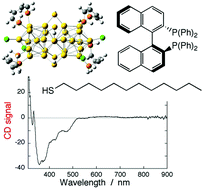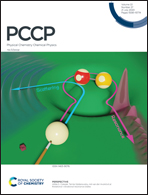Strong chiroptical activity in Au25 clusters protected by mixed ligands of chiral phosphine and achiral thiolate†
Abstract
We report the successful synthesis of a chiroptically active Au25 cluster protected by mixed ligands of chiral bidentate S-BINAP and achiral dodecanethiol (DDT), which can be formulated as [Au25(S-BINAP)4(DDT)5X4] (X = Cl or Br). The UV-vis absorption spectral pattern is similar to that of the well-known bi-icosahedral cluster [Au25(PPh3)10(SR)5X2]2+, so the obtained cluster should also have a similar bi-icosahedral structure assembled from two vertex-sharing icosahedral Au13 units. With a closer inspection of the optical absorption, interestingly, the lowest-energy peak is red-shifted as compared to that of [Au25(PPh3)10(SR)5X2]2+. Quantum chemical calculations for model bi-icosahedral Au25 structures suggest the reason of the red shift. On the other hand, the obtained Au25 cluster exhibits a weak CD signature in the lowest-energy transition region, whereas higher-energy transitions have very large chiroptical responses with a maximum g-factor of 1.7 × 10−3. The calculations also give implications for the origin of the CD response in the Au25 cluster. We then believe that bi-icosahedral Au25 clusters with chirality will be a good prototype for understanding the influence of constituent Au13 units on the chiroptical activity of their assembling structures.

- This article is part of the themed collection: 2020 PCCP HOT Articles


 Please wait while we load your content...
Please wait while we load your content...